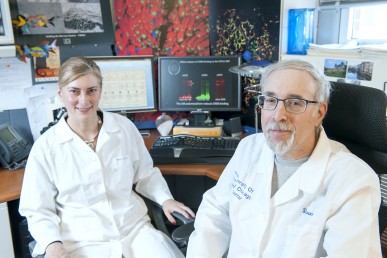Strong genetic risk factor for MS discovered in five affected siblings

Anne Boullerne, research assistant professor of anesthesiology, and Doug Feinstein, professor of anesthesiology at UIC and research biologist at the Jesse Brown VA Medical Center. Photo: Roberta Dupuis-Devlin/UIC Photo Services. (click image to download)
Researchers at the University of Illinois at Chicago have identified a genetic variation that in women significantly increases their risk of developing multiple sclerosis.
The variant occurs almost twice as often among women with MS as in women without the disease, making it “one of the strongest genetic risk factors for MS discovered to date,” said senior author Doug Feinstein, professor of anesthesiology at UIC and research biologist at the Jesse Brown VA Medical Center. The report is published in the journal ASN NEURO.
Feinstein and his colleagues were able to test three sisters among a group of five siblings between the ages of 23 and 26, all diagnosed with MS. They found the variant in all three they tested.
What they found was a genetic change known as a single nucleotide polymorphism, or SNP – a change in a single base-pair of the DNA – in a gene called STK11, which plays a role in tumor suppression and is believed to have several roles in brain function.
MS is a neurodegenerative inflammatory disease that affects approximately 2.5 million people worldwide. It causes damage to the myelin sheath, which encases neurons like the insulation on a wire. Loss of myelin interferes with the transmission of signals along the nerve fibers and impairs motor function, including walking and speech. Symptoms, which can be sporadic or progressive, range from mild to debilitating.
Genetic factors are known to influence the risk of developing MS. The UIC researchers were led to this variant thanks to a woman participating in another study at UIC. In a casual conversation, the woman told study coordinator Anne Boullerne that she and her four siblings – three sisters, including twins, and a brother – all had multiple sclerosis.
“This is an extremely rare occurrence,” said Boullerne, who is research assistant professor of anesthesiology and lead author on the paper. She said she could find no published studies with five siblings with multiple sclerosis.
“I was immediately interested in the possibility of a genetic study of the family because all five siblings – an entire generation – are affected by MS, and so we could have a very good chance of discovering key genes related to inheritance of the disease.”
The woman also described among her sisters and the women on her mother’s side of the family a prevalence of diseases associated with Peutz-Jeghers syndrome, a rare genetic disorder caused by mutations in the STK11 gene and characterized by an increased risk for certain cancers, including breast, ovary and colon cancers.
A literature search by Feinstein uncovered an article that described how mice with a disabled STK11 gene had a higher incidence of loss of myelin from the nerves of the central nervous system – a defining characteristic of MS.
The woman consented to a complete DNA-sequencing of her genome. Boullerne took a close look at the STK11 gene, where she discovered the SNP. She next obtained consent to sequence the genomes of two of the woman’s sisters and found they also carried the same SNP.
To determine if the SNP could be a contributing factor to the siblings’ multiple sclerosis, the researchers screened DNA samples from 1,400 people – 750 with MS and 650 without – provided by Jorge Oksenberg at the University of California, San Francisco, who is a leading expert on the genetics of MS. They found that the SNP was 1.7 times as prevalent in women with MS as in women without the disease, making it one of the highest known genetic risk factors for MS.
Based on their analysis, the researchers estimate that the STK11 SNP is present in about 7 percent of the general population. But because far fewer people develop MS, other genetic or non-genetic factors must play a role in the development of the disease, Feinstein said.
Feinstein and Boullerne plan to continue their hunt for other genetic factors that may contribute to MS among the five siblings and possibly their parents. They will also investigate the function of the STK11 gene in the lab, which could reveal molecular pathways involved in multiple sclerosis.
Other co-authors are Sergey Kalinin and Paul Polak, UIC research associates in anesthesiology; Fernando Testai, UIC assistant professor of neurology; Demetrios Skias, UIC assistant professor of neurology and neurologist at the Jesse Brown VA Medical Center; and Elizabeth Hartman, neurologist at the Center for Neurosciences, Orthopaedics and Spine in Dakota Dunes, South Dakota.
This research was supported by in part by a Research Career Scientist award to Feinstein and by a grant from Biogen-Idec.
